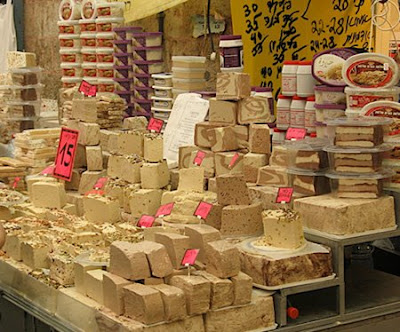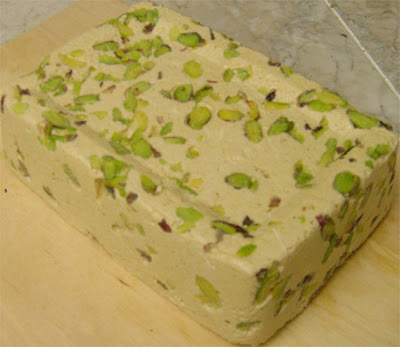
Halvah (known as Helva in Turkish, and Halvah or Halva in other languages) is a Turkish origin special sweet/dessert.
Halvah is principally made of two basic substances that are sesame oil and sugar. It also contains a slight quantity of acidity regulator (lemon salt or in other terms citric acid), halvah root consisting of a substance named soapwort extract and also natural vanilla flavour. Cocoa and roasted pistachios are added to these basic substances in the production of flavoured halvah such as cocoa halvah and pistachio halvah.
The sesame oil used in the manufacture of halvah is a product that is obtained from the grinding of sesame seeds in our automatic sesame-processing establishments and contains absolutely no additive. Besides forming a basic substance of halvah, sesame oil is itself a product offered to consumption. During the production of halvah, the syrup formerly boiled at high temperatures is beaten together with the soapwort extract to form a nougat consistency. Subsequently, it is kneaded with sesame oil in a traditional way. This process is the most important one because it influences the quality of the halvah. Following the kneading operation, the procedures of moulding, resting and packing are carried out.
Nutrition Facts of Halvah
As sesame contains rich nutriments, it provides an important nutritious supplement to sesame oil and halvah. It is particularly rich in protein, calcium, phosphor and vitamin E.
100 gr. of halvah contains minimum:
* 10 gr. of protein (25% of the recommended daily quantity);
* 255 mg. of calcium (32% of the daily needs);
* 400 mg. of phosphor (50% of the daily needs);
* 2.4 mg. of vitamin E (24% of the daily needs);
Whereas 100 gr. of sesame oil contains:
* 17 gr. of protein (34% of the recommended daily quantity);
* 426 mg. of calcium (3 times the calcium contained in milk and 53% of the recommended daily quantity);
* 732 mg. of phosphor (91% of the daily needs) as well as 4 mg. of vitamin E (40% of the daily needs).
As sesame is moreover rich in omega3 oil, it provides extra advantages for the health of the heart. With its high energetic value (500 kcal./100 gr. halvah and 595 kcal. / 100 gr. sesame oil), it proves to be ideal in meeting the needs of children in period of development, athletes and hard task workers.
Pistachio Halvah Picture

How Should Helva Be Stored?
The recommended storing temperature is of 8-12°C (46 to 54 degrees Fahrenheit) and the conditional humidity should be of 45-60%. It is generally advised to store and keep them in a dry, cool place. The humidity rate is particularly important for halvah and Turkish delights. Stopping any contact with the environment by tightly closing the halvah’s packing after opening will prevent the halvah from losing its sensory characteristics. It should be kept away from direct sunlight and should not bear any heavy weight. If not, it could be squashed and you could encounter leakage problems.
How To Order Halvah?
If you like to try this delicious dessert, you might order Authentic Turkish Helva at Amazon.
Tip: Koska Halva is the #1 selling brand in Turkey, and Koska Pistachio Halva is my personal favorite.
No comments:
Post a Comment